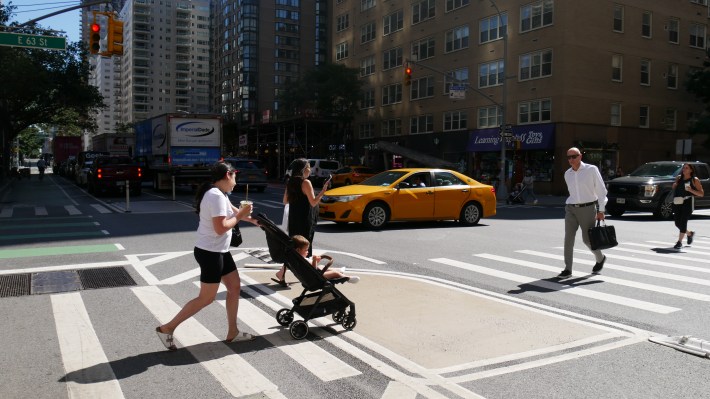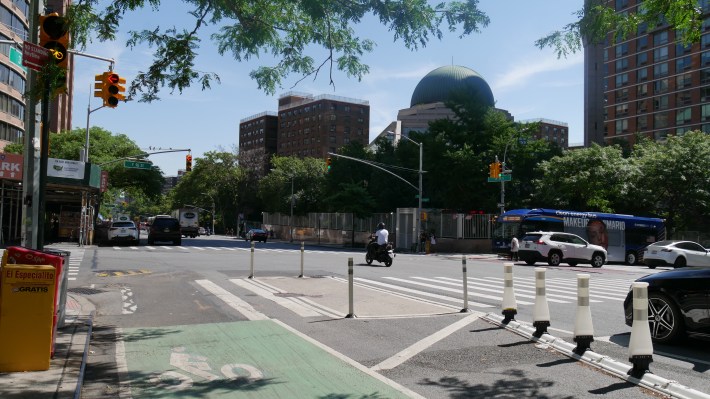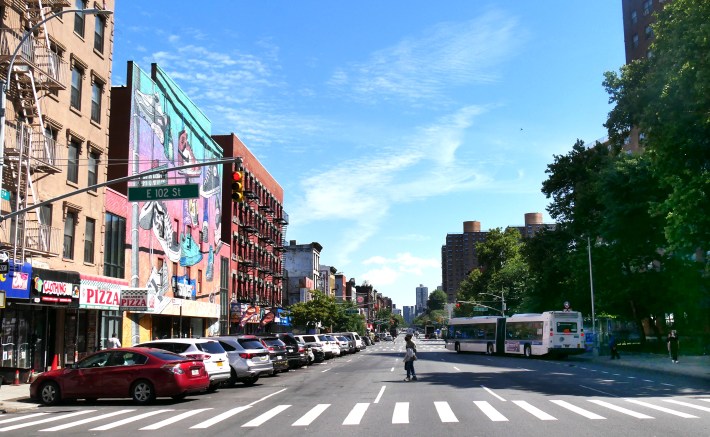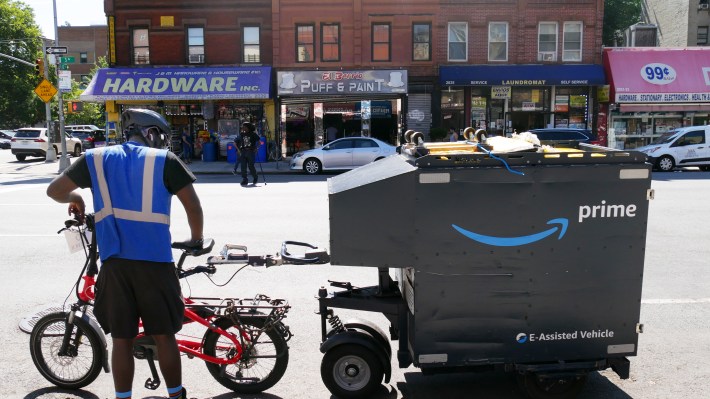Third Avenue in East Harlem will become a "complete street" with a bus lane and protected bike lane — extending a redesign already installed further south on the corridor in the Upper East Side.
The proposed redesign builds on work done on the avenue that included repurposing traffic lanes into an extra-wide parking-protected bike-lane and a bus-only lane, calming a corridor fraught with traffic violence due to its unusual width since the removal of elevated train tracks in the 1950s.
The 32-block stretch in Harlem is a "Vision Zero Priority Corridor" ranked in the top 10 percent of Manhattan's streets based on crashes resulting in death or serious injury. The strip saw 430 reported traffic injuries from 2019 to 2023. In the same period, four cyclists and 27 pedestrians died or suffered serious injuries on Third Avenue, Department of Transportation officials said in a presentation to Manhattan Community Board 11 last month.
“We’re really seeing a need here to make some safety improvements,” DOT's Rosy Doud, told the board. The agency has not finalized the design.
Based on previous efforts, the project would likely scrap one or two parking spots per block at intersections to make space for painted pedestrian islands and bike racks.

DOT previously transformed Third Avenue from 59th Street to 96th Street, implementing a so-called "complete street" design that includes dedicated lanes for bikes and buses. The Adams administration wants to extend the improvements south to 23rd Street as well.
But when the city proposed the scope of the Upper East Side design in 2022, DOT's limited ambitious disappointed advocates and experts.
A "perfect New York City Street" plan, published in Curbed in 2021 imagined a more robust transformation — with extra-wide bike lanes, extended sidewalks that double pedestrian space, a busway, improvements to sanitation infrastructure and lots of trees.
DOT's design for Third Avenue on the Upper East Side fell far short of that. Now the agency wants to continue the improvements up into East Harlem — likely using the same toolkit.

Between 96th and 128th Street, the 70-foot roadway currently has a whopping five lanes for private vehicular traffic. This section of Third Avenue has no bike or bus lanes, despite heavy use by cyclists and buses. The corridor serves thousands of bus riders everyday who must deal with embarrassingly slow speeds.
“We have a combined 70,000 weekday riders on Third Avenue, with 17,000 on this section alone,” said Doud.
Based on DOT's traffic counts, the corridor has excess vehicular capacity, even in rush hour. Repurposing traffic lanes into bike lanes and bus lanes increases street safety, according to DOT stats.
The city installed a bike lane in 2010, and crashes with injury went down 27 percent uptown on Columbus Ave. On 125th Street from Amsterdam Ave to Second Avenue, there has been a 33-percent reduction in bus travel times and an 11-percent reduction in injuries since adding a "bus-only" lane, according to DOT.

At the community board meeting, multiple residents claimed they felt creating a bike lane would contribute to more traffic, and griped that delivery workers don’t use bike lanes.
“You think that adding a bike lane would keep the bikes in that lane. What I see is bikes are weaving in and out of traffic. They aren't using the bike lanes that much,” said board member Rev. Michelle Wiltshire-Clement.
Board member Kenneth Crouch, who said he biked to the meeting on Third Avenue, disagreed.
“I have to respectfully disagree with you. Bikers tend to stick to their lane when it is a protected lane,” said Crouch.
When Streetsblog recently observed behavior on the already-completed section of Third Avenue, delivery workers on e-bikes used the protected bike-lane almost exclusively. Because the lane is wider than the standard city lane, regular bikes and e-bikes were able to co-exist more peacefully.

On Third Avenue and 112th Street, an e-bike clad delivery worker said he would welcome new lanes.

"[Drivers] are always trying to run me off the road up here," said Naquan, who delivers for Amazon in Harlem.
Unsurprisingly, some board members expressed concern about car owners losing parking, even though only 15 percent of households own cars in the district. Just seven percent of residents in the district drive to work; the vast majority take public transit, walk, or work from home.
“I want a minimum amount of parking affected by this. I know this is going to go in, how it goes in is what we can manage. Our constituency here is fighting for parking space left and right, they want to have cars,” said CB 11 Public Safety and Transportation Committee Chair Jose Altamirano.
DOT plans to come back to the board with a design sometime in the fall.






